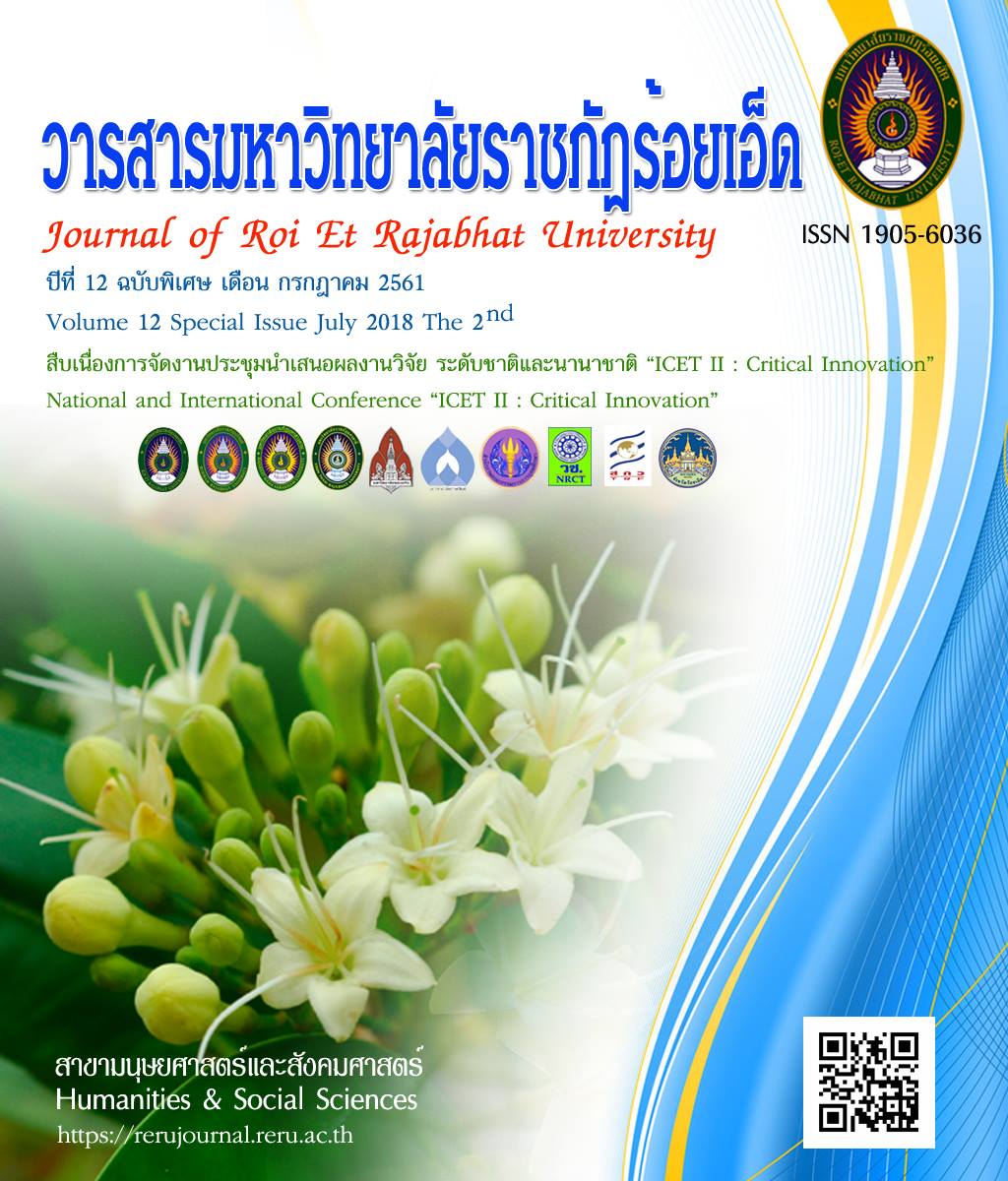Creativity Development of The Student with Augmented Reality by Active Learning
Keywords:
Creativity, Augmented Reality, Active LearningAbstract
This research is the development of creativity based on Guilford concepts with augmented reality
by active learning,. The population of research were 155 students of education computer, department of
computer, Nakhonphanom University, who studied in the third year, semester 2016. The research results
found that: 1) students satisfied the learning to create augmented reality by active learning at very high level
( = 4.38). 2) students had a very good overall level of creativity (
= 13.54), if you consider by item you
found that : the initiative was very good ( =13.95), fluency was very good (
= 13.41), and flexibility was
very good ( = 13.26), initiative and fluency were significant difference at .05 level, initiative and flexibility
were significant difference at .05 level, fluency and flexibility were not significant difference at .05 level.
References
BU Academic Review, 7(2) : 9-21.
เกรียงศักดิ์ เจริญวงศ์ศักดิ์. (2549). การคิดเชิงสร้างสรรค์. (พิมพ์ครั้งที่ 7). กรุงเทพฯ: ชัคเซสมีเดีย.
จุฑารัตน์ บันดาลสิน. (2557). การพัฒนาความคิดสร้างสรรค์สู่นวัตกรรมการบริการพยาบาล. วารสารพยาบาลทหารบก, 15(3), 9-17.
เฉลิมชัย กิตติศักดิ์นาวิน. (2554). ความสัมพันธ์ระหว่างความคิดสร้างสรรค์ของบุคคล เชาวน์อารมณ์ (EQ) และเชาวน์ทางจิต (SQ),
หาดใหญ่วิชาการ, 9(1) : 75-82.
เดชา เดชะวัฒนไพศาล, มณีนุช จันทร์เที่ยง, วรกัญญา ตันติไวทยกุล และอัจจญา อภิวาท. (2554). ผลกระทบของสภาพแวดล้อม
ในการทำงานและคุณลักษณะส่วนบุคคลต่อระดับความคิดสร้างสรรค์. วารสารพัฒนบริหารศาสตร์, 51(3): 1–33.
มณฑาทิพย์ ไชยศักดิ์. (2552). การพัฒนาความคิดสร้างสรรค์ในการพยาบาล. บทความวิชาการการศึกษาต่อเนื่อง
สาขาพยาบาลศาสตร์ เล่มที่ 8 การบริหารการพยาบาล. กรุงเทพฯ: ศิริยอดการพิมพ์.
ศิริพร มโนพิเชษฐวัฒนา. (2547). การพัฒนารูปแบบการจัดการเรียนการสอนวิทยาศาสตร์แบบบูรณาการที่เน้นผู้เรียน
มีส่วนร่วมในการเรียนรู้ที่กระตือรือร้นเรื่องกายมนุษย์. วิทยานิพนธ์ ปริญญาการศึกษาดุษฎีบัณฑิต
สาขาวิชาวิทยาศาสตรศึกษา. กรุงเทพฯ: มหาวิทยาลัยศรีนครินทรวิโรฒ.
AKSORN. (2560). Active Learning คืออะไร? สอนยังไงให้เป็น Active Learning?. สืบค้นเมื่อ 25 พฤษภาคม 2561,
จาก http://www.aksorn.com/active-learning/
Balasubramian and Greethapriya. (2007). The Effect of Active Learning in an Interior Design Daylighting
Module. Master Abstract International, 45(2) : 181.
Guilford, JP. (1980). Cognitive Styles: What are they?. Journal of Education and Psychological Measurement,
40 : 715–753.
Mckeachie, W. J.; Pintrich, P. R.; Lin, Y. G. and Smith D. A.. (1987). Teaching in the Learning in the
College Classroom : A Review of the Literature. Ann Arbor : National Center for Research to
Improve Postsecondary Teaching and Learning. The University of Michigan.
Renner, J., Abraham, M. (2008). The Necessity of Each Phase of the Learning Cycle in Teaching High School
Physics. Journal of Researh in Science Teaching, 25(1) : 39-58.
Downloads
Published
How to Cite
Issue
Section
License
บทความที่ได้รับการตีพิมพ์เป็นลิขสิทธิ์ของวารสารมหาวิทยาลัยราชภัฎร้อยเอ็ด
ข้อความที่ปรากฏในบทความแต่ละเรื่องในวารสารวิชาการเล่มนี้เป็นความคิดเห็นส่วนตัวของผู้เขียนแต่ละท่านไม่เกี่ยวข้องกับมหาวิทยาลัยราชภัฎร้อยเอ็ด และคณาจารย์ท่านอื่นๆในมหาวิทยาลัยฯ แต่อย่างใด ความรับผิดชอบองค์ประกอบทั้งหมดของบทความแต่ละเรื่องเป็นของผู้เขียนแต่ละท่าน หากมีความผิดพลาดใดๆ ผู้เขียนแต่ละท่านจะรับผิดชอบบทความของตนเองแต่ผู้เดียว





